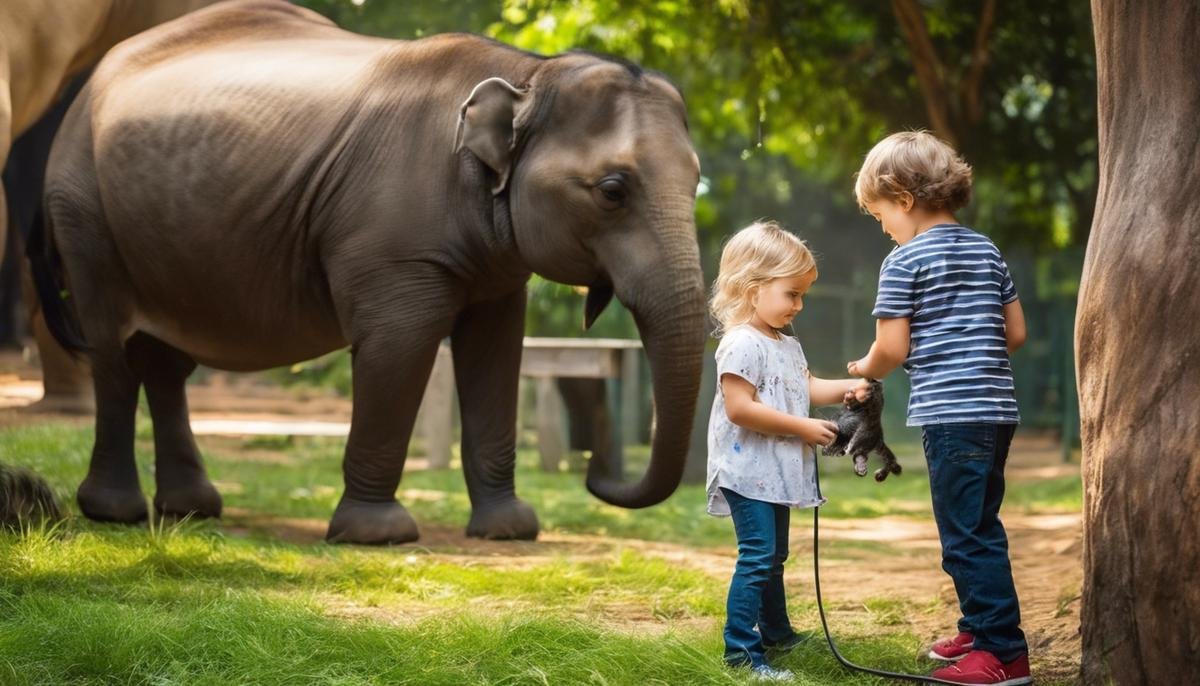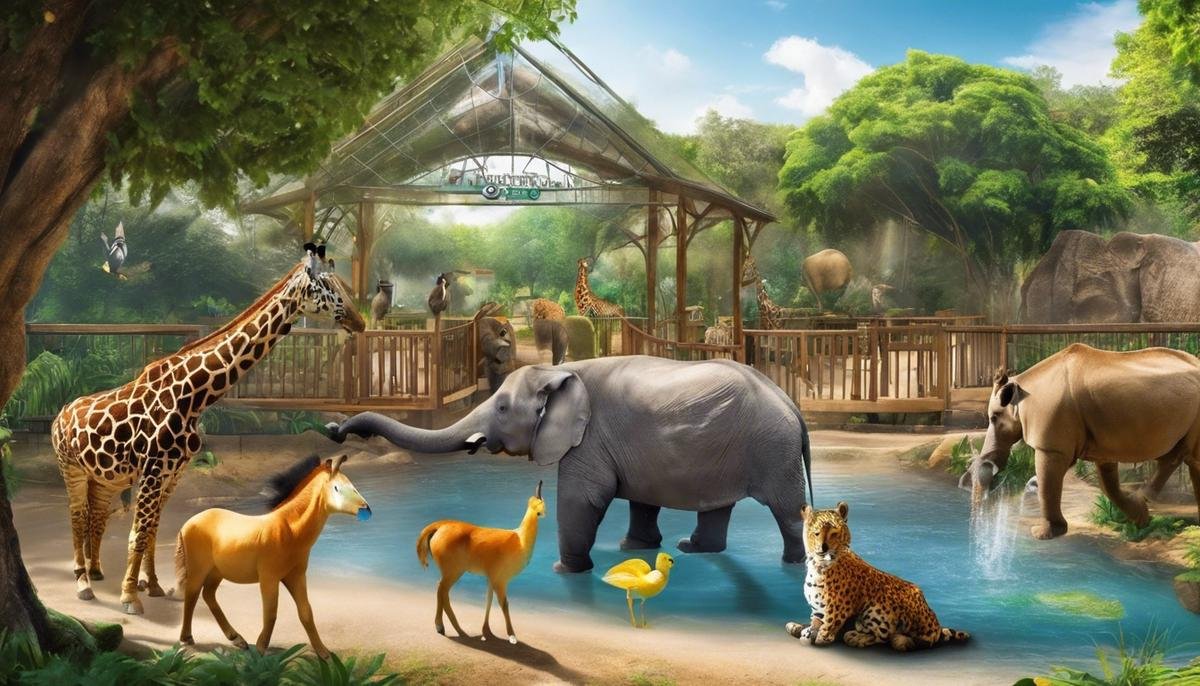
Autism Spectrum Disorder (ASD) is a complex condition that affects a person’s social interaction, communication skills, and includes a range of repetitive and characteristic behaviors. For children diagnosed with this disorder, everyday activities and conventional learning methods can be particularly challenging. However, innovative and unconventional therapeutic approaches, such as Zoo Therapy, have emerged as incredibly beneficial tools, impacting positively on the life of children with autism. In an educational, engaging, and empathetic manner, this piece strives to shed light on the majestic blend of nature and therapy through a therapeutic approach that is as intriguing as it is beneficial – Zoo Therapy for children with Autism.
Understanding Autism and Children
As families- truth be told, we all cherish our kids fiercely and want them to grow up safe, healthy, and happy. One significant contributing factor to ensuring this often depends on being informed. Today, let’s delve into a topic that’s widely misunderstood yet tremendously crucial- Autism. It’s important to know the characteristics of Autism and how they manifest in children. This helpful comprehension can empower us to guide our children effectively and provide a nurturing environment for growth.
Autism, or Autism Spectrum Disorder (ASD), is a complex developmental condition affecting communication, social interactions, and behaviors. Now, the “spectrum” part comes from the fact that children with autism can vary widely in their skills, behaviors, and challenges. It’s not a one-size-fits-all summary of characteristics, instead, it’s a multi-colored mosaic with individual children possessing unique combinations of traits.
First up on the radar is communication. Quite a prominent characteristic of autism is disrupted verbal and non-verbal communication. This isn’t just limited to speech delay or a lack of spoken language. Children on the spectrum may communicate in ways we’re not typically accustomed to. They may endlessly repeat certain phrases, respond to questions with unrelated answers, or sometimes, not respond at all.
Next on the list of characteristics is difficulty with social interaction. Children with autism may struggle with understanding other’s feelings, expressing their emotions, or picking up on social cues. They may prefer solitude or seem detached from their surroundings. But remember, this isn’t because they’re aloof. It’s simply how their brain is wired differently.
Then there’s the realm of behavior. Many children with Autism have specific patterns of behavior. This could include repetitive movements, like rocking or spinning, intense fixation on certain interests, insistence on routine, or particular sensitivities to sensory input such as light, sound, or touch.
Now, it’s vital to bear in mind that these traits aren’t negative. Let’s steer clear from labelling them as ‘problems’. These are simply characteristics that indicate a child’s brain is wired differently, and that they experience the world in a unique way.
It’s also important to note that there are children who show signs of Autism early on, while others develop normally for a few months or up to two years and then regress. This shows how diverse the spectrum can be. So, if your nugget seems to be showing some of these characteristics, it could be a good idea to consult with a health professional for an expert opinion.
Learning about Autism is pivotal, not just for parents but for anyone interacting with children. Understanding, awareness, and compassion can make all the difference in the world. And when equipped with knowledge, we can create an environment where every child, irrespective of whether they’re on the spectrum or not, can flourish and thrive.
Support, love, patience, and acceptance can fuel a child’s journey, inviting them to shine bright in their own brilliant way. Always letting them know, in all unwavering certainty, that they are wonderfully and beautifully them.

Explaining Zoo Therapy
The Power of Zoo Therapy for Children with Autism
Taking a fresh and innovative approach in the realm of autism intervention is Zoo Therapy, also known as Animal-Assisted Therapy (AAT) — a unique way of improving the quality of life for children diagnosed with Autism Spectrum Disorder (ASD). Here’s a closer look at how this type of therapy works and how it could be extremely beneficial for your child’s developmental progress.
Zoo Therapy, in a nutshell, is an interactive form of therapy where animals are used in the treatment process to assist in achieving a myriad of therapeutic goals. It is based on the strong bond that tends to form between humans and animals — something that transcends all barriers, including those associated with autism.
The animals used for therapy are typically tame and docile, and they range from domestic pets such as dogs or cats to more exotic species that can often be found in a zoological environment, for instance, parrots, small mammals, and even reptiles. Each animal is specifically chosen based on its conduct and behavior and the intended therapeutic goals.
The therapeutic interaction between children and animals encourages the development of communication skills and fosters emotional connections. It’s important to note that every therapy plan is fine-tuned to fit the specific needs of the child.
In fact, countless studies have outlined the benefits of Animal-Assisted Therapy for children with autism. Benefits such as reduced anxiety, enhanced social interaction skills, increase in willingness to communicate, and even improvement in motor skills have been noted.
A primary benefit of this therapy lies with its flexibility. A therapy session can occur in a variety of settings, from the traditional clinical location to a local zoo or animal therapy center. Zoo Therapy is so much more than just a casual visit to the local zoo. It’s the strategic process of animal-human interaction to accomplish set therapy goals.
Moreover, choosing a zoo as the primary setting for therapy naturally presents opportunities for additional family bonding and recreational activities, further reinforcing and extending the therapeutic value.
Remember that each child on the autism spectrum is unique, with individual skills and challenges. Similar to other forms of therapy, the effectiveness and outcomes of Zoo Therapy can vary between children. And while therapy plays an essential role in management, it is crucial to bolster this with a loving, supportive environment at home – a nurturing setting where all children, regardless of their neurological makeup can grow, thrive, and shine.
As a parent or caregiver, you should always be open to exploring different therapy methods for your child. If you think your child may benefit from Zoo Therapy, engage with a professional for advice. They may help inform you about the options available in your area or guide you in forming a personalized zoo therapy plan that could be the perfect fit for your child.
Zoo Therapy, while a comparatively unique approach, carries immense potential in helping children with autism to navigate through their world. With its aid, the world, as they perceive it, could be a lot less daunting and much more enjoyable. Every child deserves the chance to grow within a world bright with opportunities and joy, and this form of therapy just might pave the way towards it. So, embrace the unexpected, dive into the world of Zoo Therapy, and witness the positive changes it can bring about in your family’s life.

Practical Guide to Arranging Zoo Therapy
Shifting the Spotlight to Zoo Therapy for Children with Autism
You’ve already learned about Autism and the unique challenges and characteristics that can be associated with the spectrum. It’s crucial to remember that every child is an individual with their own experiences and needs. Now, let’s explore the intriguing topic of zoo therapy and how it can benefit children with autism.
When we think of child therapy, often strict clinical settings come to mind. But what if therapy could introduce fun, natural, and animal interactions into the mix? That’s precisely where zoo therapy, a type of Animal-Assisted Therapy (AAT), comes into play. The idea is to use animals as facilitators in achieving specific therapeutic goals.
Animals have an incredible ability to create a soothing environment which promotes emotional and social growth, making them ideal companions for therapy. From smart dolphins to cuddly dogs, rabbits, or even riding horses, the types of animals used are diverse, all playing an extraordinary role.
Goals for therapy are always unique to the child involved. For a child with autism, for instance, a therapeutic interaction could focus on enhancing social and emotional skills through the process of grooming a pony, or it could aim to decrease sensory sensitivities via the gentle experience of petting a rabbit.
One of the most remarkable aspects of this type of therapy is its flexibility. You may find that you’re not only in zoos or designated therapy centers but farms, aquariums, or even your backyard. Imagine organizing a family picnic where siblings can interact in a therapeutic setting while bonding – it’s therapy that doesn’t feel like therapy.
Of course, like any other treatment method, there’s no one-size-fits-all when it comes to zoo therapy. Some children might find animals intimidating, while others could break through their communication challenges. Therefore, it’s crucial to approach this with curiosity, patience, and always wit the guidance of a professional who understands your child’s needs intimately.
A golden thread that ties all these therapies together is the nurturing environment at home. A home that sees and accepts autism as a different way of connecting to the world can make each therapeutic step more effective. So, it’s more than just about organizing these sessions. It’s about instilling that aura of acceptance, empathy, and recognition within the folds of your family life.
Feeling overwhelmed? Don’t be! All of these are the staircase to creating a vibrant life for your child, but they don’t need to be ascended all at once. It’s always recommended to seek advice from professionals and educators to choose the right therapy options for your child.
Zoo therapy is about more than achieving set milestones. This experience can provide moments of pure joy, building memories, fostering growth, and nurturing a connection between children and the natural world around them. It gives children another way to navigate life on their terms and empowers parents with another tool to support them.

Case Studies of Zoo Therapy
With a clear perspective on the intricate nuances of Autism and the unique benefits of Zoo Therapy, let’s delve a little deeper to examine successful case studies of children with autism who have reaped the benefits of this remarkable approach to therapy.
One such case is of a young boy named Ethan, highlighted in a study by ‘American Journal of Occupational Therapy’. Ethan, diagnosed with Autism Spectrum Disorder (ASD), communicated largely through echolalia (repeating words and phrases). At the tender age of eight, reliable interaction with others seemed like a challenge. Enters Zoo Therapy. A special program structured around his needs introduced Ethan to several animals at a local zoo. The impact? Profound, to say the least. Ethan began showing signs of enhanced focus, engagement, and even started using appropriate spontaneous language more frequently. It appeared as though the animals had managed to reach Ethan in a way human interactive efforts could not.
Similarly, a research funded by the Human Animal Bond Research Initiative (HABRI) explores the incredible journey of Alice, a girl with autism. Through regular visits to a farmstead which provided Zoo Therapy, Alice discovered a fresh way to connect with the world. She showed considerable improvements in her social engagement, demonstrating increased eye contact and exhibiting less burdened conversations. Her anxieties reduced, and she started displaying enthusiasm for her regular therapeutic visits. Alice’s parents were thrilled to watch their child bloom in a space where she felt accepted and enjoyed engaging connections.
These compelling accounts affirm the potential of Zoo Therapy in autism treatment. But it is essential to remember that these experiences can vastly differ, reflecting each child’s unique psychological landscape. For instance, an energetic child might have an enriching experience with active animals like dogs or rabbits, while a child who values quietude may resonate more with calm animals like turtles.
Thus, when contemplating Zoo Therapy, it is vital to consider the child’s unique needs and personal inclinations. In some cases, children may need time to warm up to their new animal companions. Patience, here, is key, as hastened steps can cause undue stress. Remember, every child has a unique timeline and to note each progress, no matter how small, is a victory.
Moreover, parents play an unbeatable role in this journey. From witnessing their child’s first successful interaction with the animal to being the pillars of support in moments of discomfort or distress, their involvement enriches the therapy’s effectiveness tenfold.
It’s not just about therapy; it’s also about spreading awareness and acceptance for children with autism. Formulating inclusive spaces that encourage understanding, conversation, and support within the community can pave the way for a future where children with autism no longer feel sidelined, but embraced and understood.
At the heart of it, Zoo Therapy espouses a philosophy underlined by empathy, understanding, and love– values that are universal and relevant for all. And who knows? In the effort to create a world where every child, with autism or not, is cherished and nurtured, we may just stumble upon a deeper, more profound connection with our four-legged friends. They say it takes a village to raise a child; perhaps, it takes a zoo to help them soar!

Children with Autism Spectrum Disorder are unique, blessed with extraordinary potentials that often require unique approaches to tap into and further develop. While the journey through treatment is a long and winding road, hope and help abound at every corner. One such source of help is Zoo Therapy – a therapeutic tool that not only enhances their sensory experiences, motor skills, emotional bonding, and social skills, but also brings unparalleled joy, learning, and satisfaction. As we have explored in the above sections, and illustrated through captivating case studies and insightful anecdotes, Zoo Therapy, coupled with other therapeutic methods, can make a substantial positive difference. Beyond doubt, this dynamic, engaging, and beneficial therapy is a jungle of growth, development, and happiness waiting to be explored by more children with autism.




